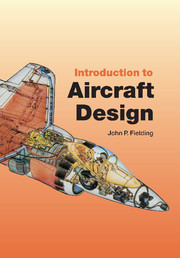Book contents
- Frontmatter
- Contents
- Preface
- Acknowledgements
- 1 Introduction
- 2 Why should we design a new aircraft?
- 3 Why is it that shape? – Civil aircraft
- 4 Why is it that shape? – Other types
- 5 What's under the skin? – Structure and propulsion
- 6 What's under the skin? – Airframe systems
- 7 What's under the skin? – Avionics, flight control and weapon systems
- 8 Why do aircraft cost so much?
- 9 What help can I get? – Bibliography and computer-aided design
- 10 The shape of things to come – Should the project continue?
- 11 What can go wrong? – Some lessons from past aircraft projects, and a glimpse into the future
- Appendix A Useful aircraft design data
- Appendix B A–90 parametric study. Example – the A-90 500-seat airliner
- Appendix C The prediction of aircraft reliability and maintainability targets
- References
- Index
10 - The shape of things to come – Should the project continue?
- Frontmatter
- Contents
- Preface
- Acknowledgements
- 1 Introduction
- 2 Why should we design a new aircraft?
- 3 Why is it that shape? – Civil aircraft
- 4 Why is it that shape? – Other types
- 5 What's under the skin? – Structure and propulsion
- 6 What's under the skin? – Airframe systems
- 7 What's under the skin? – Avionics, flight control and weapon systems
- 8 Why do aircraft cost so much?
- 9 What help can I get? – Bibliography and computer-aided design
- 10 The shape of things to come – Should the project continue?
- 11 What can go wrong? – Some lessons from past aircraft projects, and a glimpse into the future
- Appendix A Useful aircraft design data
- Appendix B A–90 parametric study. Example – the A-90 500-seat airliner
- Appendix C The prediction of aircraft reliability and maintainability targets
- References
- Index
Summary
Introduction
This book has attempted to give an introduction to most aspects of aircraft design, with emphasis on giving the reasons for the shapes of aircraft, and descriptions of their constituent parts. The preface clearly stated that it was not intended to produce a book about aircraft conceptual design, as many good texts are currently available. Some of these are referred to in the previous chapter, and they should be used, with help, to produce aircraft conceptual designs. Conceptual designs, however, are not usually end-products, but merely important steps in the whole design–manufacture–operation cycle.
Conceptual designs must be objectively assessed to see if they warrant the significantly increased expenditure that would be required to perform preliminary and detailed design. A vital precursor to this decision-making process is a clear definition of the characteristics of the conceptual design, and this is discussed in Section 10.2. Section 10.3 shows the options that are available following a conceptual design process, and Section 10.4 describes simple decision-making techniques. The final section of this chapter gives an example of a conceptual-design definition, and describes the decisions that were made about its future.
Conceptual design definition
It is important to summarize clearly the results of the conceptual design process by providing the following types of information:
(i) Configuration description – This will be defined by means of conventional engineering drawings, tabular data, computer models, physical models or a combination of these methods, together with a brief description of the rationale of the design.
[…]
- Type
- Chapter
- Information
- Introduction to Aircraft Design , pp. 149 - 162Publisher: Cambridge University PressPrint publication year: 1999



